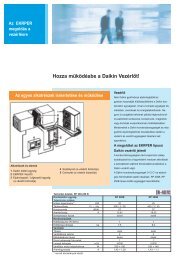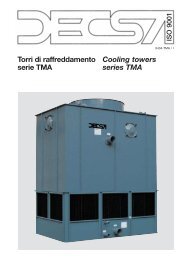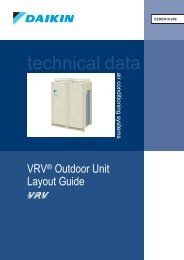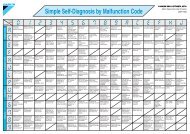1. D-BACS - Daikin
1. D-BACS - Daikin
1. D-BACS - Daikin
You also want an ePaper? Increase the reach of your titles
YUMPU automatically turns print PDFs into web optimized ePapers that Google loves.
Fundamental of DIII-NET<br />
8. Combination of Multiple Central Remote Controllers <br />
8.1 Check for Centralized Control Devices in Simultaneous Use<br />
intelligent Touch Controller requires the following two settings. Note that these settings may vary depending on<br />
the types of centralized control units in simultaneous use. Check for centralized control units in each customer<br />
and list the necessary intelligent Touch Controller settings in the form of the next page, referring to a summary<br />
given in the following table before starting to make the settings.<br />
<strong>1.</strong> Making the setting for the master or slave<br />
When two intelligent Touch Controller’s are connected or one central controller and one intelligent Touch<br />
Controller are used, one unit must be set up as the master and another as the slave.<br />
(Only the intelligent Touch Controller set up as the master permits you to make the settings for remote control<br />
permission/inhibition and setup temperature limitation.)<br />
*Note that the intelligent Touch Controller must be set up as the master when only one intelligent Touch<br />
Controller is available.<br />
2. Setting the connector for DIII-NET parent centralized control<br />
Attach the connector only to one of the centralized control units connecting to the DIII-NET<br />
communication line and remove all the other centralized control units.<br />
Only the unit provided with the connector supplies power to the DIII-NET communication line.<br />
Upper Middle<br />
Lower<br />
Read the following descriptions for master/slave settings and relationship among settings required<br />
for DIII-NET parent centralized control.<br />
intelligent Manager<br />
BACnet ® Interface<br />
DMS-IF<br />
Unit name<br />
Parallel interface<br />
intelligent Touch<br />
Controller<br />
Central controller<br />
DIII-NET PLUS adaptor<br />
ON/OFF controller<br />
Connector setup for DIII-NET parent centralized control Master/slave setup<br />
Be sure to always mount the<br />
connector for parent centralized<br />
control.<br />
For presence of upper unit<br />
⇒ Remove the connector for parent<br />
centralized control.<br />
For absence of upper unit<br />
⇒ Attach the connector for parent<br />
centralized control to one of the<br />
middle-grade units for use.<br />
For presence of upper or middle unit<br />
⇒ Remove the connector for parent<br />
centralized control.<br />
For absence of upper and middle units<br />
⇒ Attach the connector for parent centralized<br />
control to one of the lower units for use.<br />
No master/slave setting required.<br />
(Remote control inhibition can be<br />
allowed at any time.)<br />
Set one of the middle units as the master and<br />
another as the slave.<br />
Master = Settings for remote control inhibition<br />
can be made (when the upper unit is not used).<br />
Slave = Settings for remote control inhibition<br />
cannot be made.<br />
When the upper unit is used together :<br />
⇒ Settings for remote control inhibition cannot<br />
be made.<br />
*DIII-The NET PLUS adaptor has no<br />
master/slave relationship.<br />
For details of master/slave settings<br />
on the ON/OFF controller, refer to<br />
the D-<strong>BACS</strong> Design Guide.)<br />
8.1 Check for Centralized Control Devices in Simultaneous Use 49







